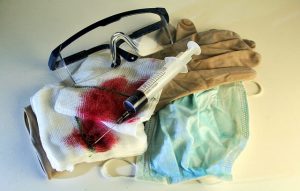 Print a Sign-In Sheet | Spanish Version
Print a Sign-In Sheet | Spanish Version
Human Immunodeficiency Virus (HIV)
The human immunodeficiency virus (HIV) is the virus that causes AIDS (Acquired Immune Deficiency Syndrome). HIV makes people sick by attacking the immune system and keeping it from being able to fight infection. Eventually these infections take over, and the person with AIDS dies. There is no cure for AIDS. However, by taking a few simple precautions, you can set your mind at ease.
Hepatitis B Virus (HBV)
Hepatitis B virus is a potent bloodborne virus that attacks the liver, causing illness and sometimes death. The chronic Hepatitis B infection exhibits the following: can’t clear virus from the liver, those infected cannot develop immunity, and there are severe long-term consequences. However, HBV is one of the few serious infectious diseases that can be prevented with a safe, effective vaccine. Vaccination is recommended if you are traveling or work in a profession with a high risk of exposure.
Transmission of HIV and HBV
Both HIV and Hepatitis B can only be transmitted through blood, semen, vaginal secretions, and bodily fluids that might be exposed as a result of the injury. Additionally, HBV can survive for at least one week in dried blood, at room temperature, on environmental surfaces. HIV once dried, will have a 90-99% reduction of HIV concentration within several hours:
- Pathogen is present
- Portal of entry is available
- Host is susceptible
- A sufficient quantity of the bodily fluid/virus is present
Protecting Yourself
To protect yourself from HIV and Hepatitis B, wear latex gloves if you will be in contact with bodily fluids and use a pocket mask when giving CPR.
If you come in direct contact with bodily fluids, use the following method of hand washing:
- Use soap and running water
- Rub your hands vigorously
- Wash all surfaces including: backs of hands, wrists, between fingers, under fingernails
- Rinse well
- Dry hands with a paper towel
- Turn off the water using a paper towel instead of bare hands
Bloodborne Pathogens: Universal Precautions
To protect yourself from the unknown, take these precautions as part of your daily routine.
Always:
- Treat blood and bodily fluids as if they were infected
- Protect yourself, when appropriate, with latex gloves and pocket masks for CPR
- Bandage cuts, scrapes and broken skin
- Wash hands and exposed areas with soap and water immediately after exposure
- Discard sharp objects in appropriate containers
Never:
- Break, bend, or recap used needles or other sharp objects
- Eat, drink or store food in an area with potential exposure
- Smoke, put on makeup or handle contacts in an area with potential exposure
- Pipette infectious liquids by mouth
Remember:
OSHA requires that potentially infectious materials be kept in containers that are:
- Red
- Labeled with biohazard symbol
- Or both
KEMI does not assume liability for the content of information contained herein. Safety and health remain your responsibility. This information is to be used for informational purposes only and not intended to be exhaustive or a substitute for proper training, supervision or manufacturers’ instructions/recommendations. KEMI, by publication of this information, does not assume liability for damage or injury arising from reliance upon it. Compliance with this information is not a guarantee or warranty that you will be in conformity with any laws or regulations nor does it ensure the absolute safety of any person, place or object, including, but not limited to, you, your occupation, employees, customers or place of business.

